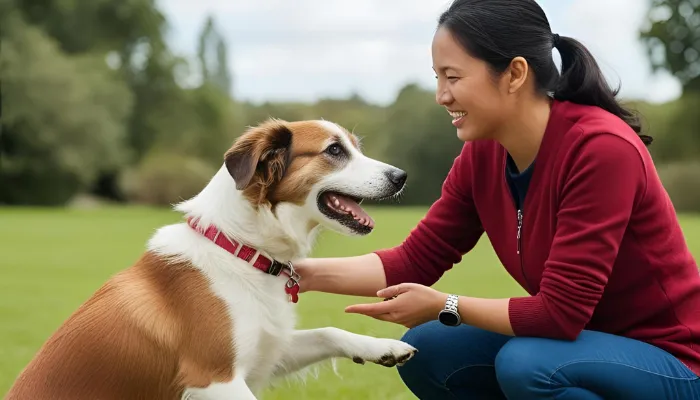Everybody is well aware that dogs are loveable pets. They experience various emotions, one of which is sadness. What do dogs say when they are sad? Dogs do not speak human languages, but they do express their feelings using sounds, movements, and behaviors. If you have thought about a dog translator, then you are not alone! Interpreting a dog’s different expressions can aid you in addressing their emotions more aptly. In this blog, we’ll look into the different ways dogs portray sadness, and the different ways that you can comfort them.

How Do Dogs Communicate Sadness?
One has to understand the cause of the dog’s sadness in order to be able to offer comfort. How can you tell when dogs are feeling low? Typically, their actions provide insights.
1. Vocal Expressions of Sad Dogs
Dogs make different sounds when they are sad. Some of these include:
- Whining or Whimpering: This is a sound that is non open and often is close to distress.
- Sighing: When deeply frustrated a dog is likely to be sad, and a sign of that in a dog is a deep sigh.
- Low-pitched Howls: Should a dog feel lonely much like wolves, a dog will often howl.
- Soft Barking: For some people, soft barking will be perceived as a way of trying to convey one’s sentiments while other describe it as excessive soft barking.
2. Body Language of a Sad Dog
Besides vocal sounds, dogs display sadness through body language:
| Body Language | Meaning |
|---|---|
| Drooping ears | Feeling low or submissive |
| Tail tucked between legs | Fear or sadness |
| Lack of eye contact | Avoidance or feeling down |
| Slow movements | Indicating a lack of enthusiasm |
Dogs express sadness through vocal sounds and body language, making it essential to recognize these signs. Understanding their emotions helps in offering comfort and reassurance. What do dogs say when they are sad? Their whines, sighs, and low howls reveal their feelings.
Why Do Dogs Feel Sad?
Understanding the reasons behind a dog’s sadness helps in providing comfort. What do dogs say when they are sad? Their behavior often gives clues.
1. Separation Anxiety
When put together, a dog that is left alone for long periods will feel sad.
2. Loss of a Companion
If a fellow pet or family member is gone, dogs mourn just like humans.
3. Change in Routine
A sudden change in schedule can make dogs feel unsettled.
4. Lack of Attention
‘Out of pettiing range’ makes dogs unhappy.
Dogs experience sadness due to loneliness, loss, routine changes, or lack of attention. Recognizing these emotions helps provide comfort and reassurance. What do dogs say when they are sad? Their whimpers, sighs, and withdrawn behavior speak volumes.
How to Comfort a Sad Dog?
If your dog seems down, here is a tiny list that should allow you to put a smile on their faces instantaneously.
1. Spend More Time Together
- Increasing the amount of hours spent together, through walking, playing and even cuddling will help to lift their mood.
2. Incentives that have a Personal Touch
- An uplifting new toy or a delicious treat to brighten their mood.
3. Consistency is Key
- Dogs’ lean towards regularity so make sure you follow through on your set plan.
4. Tranquilitizing Approaches
- A well sad dog can appreciate gentle strokes, petting, a soft voice, or listening to harmonizing tunes.
5. Social Interaction
- Take your dogs to a play date with other dogs or a dog’s playground.
Comforting a sad dog involves quality time, personalized treats, and a soothing environment. What do dogs say when they are sad? Their whimpers, sighs, and low howls reveal their feelings.
Signs That a Dog’s Sadness Might Need Attention
The dog may be sad for any number of reasons, and some of these can be dealt with medically or by someone who is a professional.
| Warning Signs | Possible Causes |
|---|---|
| Loss of appetite | Depression or illness |
| Excessive sleeping | Stress or boredom |
| Avoidance of interaction | Anxiety or past trauma |
| Unusual aggression | Frustration or emotional distress |
Persistent sadness in dogs may signal underlying health or emotional issues that need attention. What do dogs say when they are sad? Their behavior and vocal cues reveal their distress.
Can Dogs Recover from Sadness?
Yes! Dogs are resilient and can bounce back with love and care. What do dogs say when they are sad? Their expressions may change over time as they heal.
Steps to Help a Dog Recover:
- Be patient and observant.
- Offer consistent emotional support.
- Provide engaging activities.
- Ensure proper health check-ups.
- Celebrate small progress.
With love, patience, and care, dogs can recover from sadness and regain their joy. Supporting them through small steps makes all the difference.
Conclusion
In conclusion, dogs exhibit sadness in the form of sounds, movements, and behavioral patterns. What do dogs say when they are sad? A dog might whimper, sigh, or showcase slight signs of discomfort. Understanding these signals makes it easier for a dog owner to soothe and give the required aid. Caring for the dog adds stronger connections to one’s relationship with the dog. A little time and love can shift their mood!
